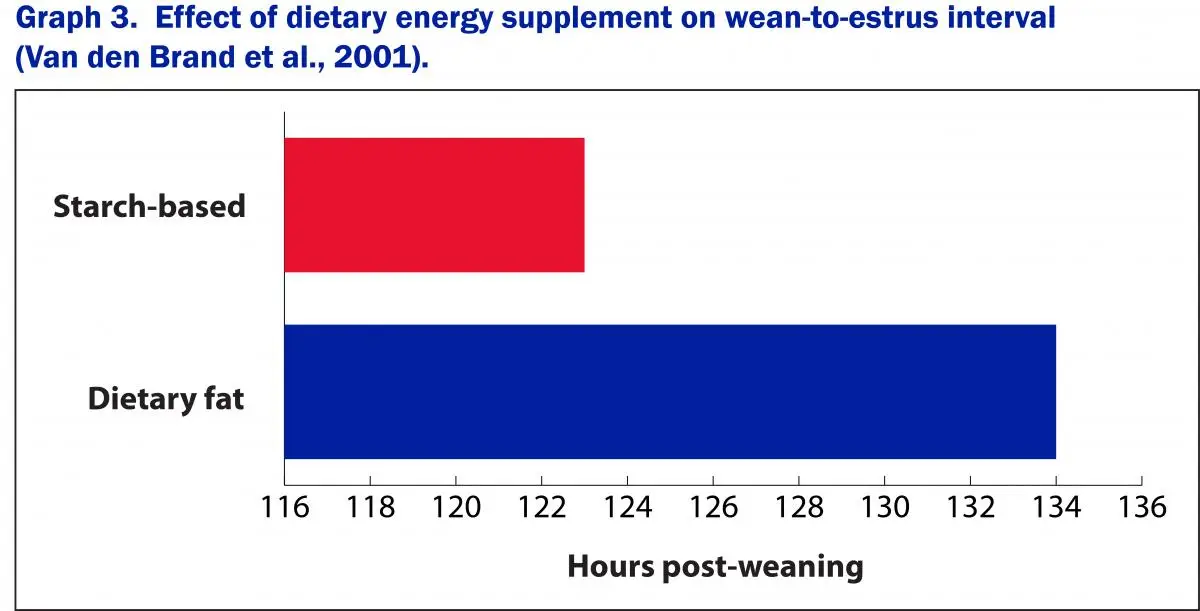
Breeding protocols and nutrition

 By Dave Chamberlin and Jaron Lewton
By Dave Chamberlin and Jaron Lewton
The productivity of a sow herd is dependent on the success of the farm’s breeding program, and the most successful breeding programs have clear and concise protocols. While every farm has its own breeding schedule and protocols, pork producers can use the following science-based tools and techniques to fine-tune their breeding program to improve the overall performance of their swine herds.
Number of matings
Relative to a single mating, Graph 1 shows multiple matings (two to three per female) significantly improve farrowing rates for gilts and multiparous sows.
Breed the right animals
- Return to estrus
Consider only breeding the sows that return to estrus within three to six days post-weaning. The post-weaning-to-mating interval impacts litter size, with sows bred three to six days post-weaning having larger litters than those bred seven to 10 days post-weaning (Xue et al., 1998). - Gilts
Gilts should be at least 30 weeks of age and 300 pounds at the first breeding. Ideally, this would be the age/weight when gilts enter their third heat cycle. Recording heat-no-service events for individual gilts is the only way to know if this goal is achieved. - Body condition
Sows with poor body condition scores (BCS) are not good breeding candidates. Sows that fall outside of BCS tolerance (less than 2 or more than 4) cost the farm money in feed and piglet loss. Allowing thin sows to skip a cycle prior to breeding can improve subsequent litter performance.
Manage boar exposure
Housing boars in a separate room from the sows and gilts may improve farrowing rates because the sows will have a heightened awareness to pheromones released by the boar when directly exposed to him.
Hygiene
Cleaning the vulva prior to breeding is a common hygienic practice, but the same wipe should not be used on multiple sows because the spread of bacteria may decrease farrowing rates (Young et al., 2010).
 Traditional AI versus post-cervical artificial insemination (PCAI)
Traditional AI versus post-cervical artificial insemination (PCAI)
Relative to traditional AI, PCAI does not necessarily improve farrowing rates, but it may allow you to reduce the concentration of sperm per dose and still achieve the same reproductive performance. This may be due to less semen backflow. Graph 2 shows the results of one study that compared the two methods and found PCAI decreased semen backflow by about 15%, which increased chances of viable semen reaching the oviduct, where fertilization occurs (Hernandez-Caravaca, et al., 2012). In addition, PCAI is also less time-consuming (up to 5 minutes less per female), which could translate into more time spent in the farrowing house or other areas of need.
Depending on the operation, farrowing rates may improve by adjusting the use of semen doses. One study observed a 6% increase in farrowing rate and 0.7 more pigs per litter when they used the oldest semen doses for the first mating and saved the freshest doses for all second matings because most sows ovulate during the latter half of estrus
(Flowers, 2020).
Nutrition
Nutrition also plays a key role in overall success before, during and after breeding. Nutrient deficiencies during lactation may impact the sow’s ability to return to estrus and ovulate upon weaning.
- Body condition
Poor BCS due to greater bodyweight losses in lactation will increase the likelihood of the sow exhibiting a delayed return to estrus. Managing the proper number of piglets per sow in lactation will optimize her breeding performance; too many piglets can increase bodyweight loss and nutrient deficiencies, while too few piglets can lead to irregular cycling (Flowers, 2020). - Flushing
Increasing feed intake through ad libitum feeding, or flushing, may improve ovulation rates and litter sizes of gilts (Cox et al., 1987; National Swine Nutrition, 2010). However, at the first mating, it is advised to return to maintenance intake levels to decrease the risk of embryonic mortality. - Energy
The specific ingredients used to maintain appropriate energy levels may impact the sow during the breeding interval. Graph 3 shows the results of one study where sows fed starch-based diets returned to estrus faster than those supplemented with dietary fat (Van den Brand et al., 2001). In this study, starch was added in the form of corn starch and dextrose as a simple sugar. Other good sources of starch include bakery byproduct and most common cereal grains, such as corn, oats, and wheat.

Every breeding program has room for improvement. Utilize these strategies, along with this Breeding Program Checklist, to help you achieve your breeding program goals. Talk with your Vita Plus consultant to learn more about any of these strategies.
About the authors: Dave Chamberlin attended Michigan State University and received a bachelor’s degree in animal science and a master’s degree in monogastric nutrition in 2017. He has experience working on a 5,000-sow farrow-to-finish farm, overseeing all farrowing management, as well as on a 700-sow farrow-to-finish unit as a farrowing manager. Chamberlin also previously worked in swine nutrition formulating rations, coordinating ingredient orders, overseeing farrowing farm management and production, and performing farm trials related to nutrition, breeding, and management. Chamberlin joined Vita Plus as a swine technical sales manager in May 2018.
Jaron Lewton was raised on his family’s hobby farm in LaGrange, Indiana, and attended Huntington University to receive his bachelor’s degree in agribusiness. During this time, he gained experience in animal husbandry as a farm hand in Laos, as well as greater knowledge of the feed industry through an internship with an egg production farm, where he specialized in nutrition and feed manufacturing. Lewton then joined a management team of a 1,500-sow operation in northern Indiana before attending Michigan State University to receive his master’s degree in swine nutrition. His thesis focused on utilizing feed additives in nursery pig diets. Lewton joined Vita Plus as a swine technical sales manager in July 2020.
| Category: |
Feed quality and nutrition Reproduction and genetics Swine Performance |

